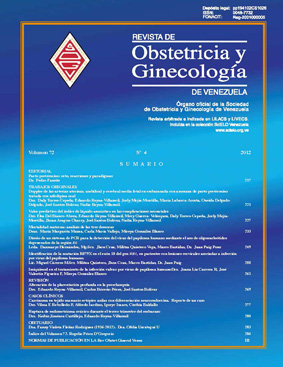Desempeño del índice proteína/creatinina para predecir proteinuria significativa en pacientes con sospecha de preeclampsia
Palabras clave:
Preeclampsia, Índice Proteína/Creatinina, Proteinuria de 24 horas, Protein/Creatinine Index, 24 Hours ProteinuriaResumen
Evaluar el desempeño del índice proteína/creatinina para predecir proteinuria significativa y secundariamente, hallar el mejor punto de corte que tuviera mejor sensibilidad y especificidad.Métodos: Estudio de prueba diagnóstica, desarrollado en un diseño transversal de pacientes expuestas al síndrome hipertensivo del embarazo las cuales desarrollaron o no preeclampsia posterior. Se seleccionaron de forma no probabilística a 173 pacientes. Se halló el nuevo punto de corte del índice proteína/creatinina mediante la curva ROC. Se calculó su sensibilidad, especificidad, valor de predicción positivo y negativo, likelihood ratios o razones de verosimilitud positiva y negativa y se relacionó con la proteinuria de 24 horas mediante la correlación de Spearman. El análisis de datos se realizó con el software STATA, versión 13.Resultados: El nuevo de punto de corte fue 0,39 con una sensibilidad de 68,3 %, especificidad de 73,5 %, valor de predicción positivo 91,3 %, valor de predicción negativo de 36,2 %, likelihood ratio + de 2,58, likelihood ratio - de 0,43 y un área bajo la curva de 0,7799. Se obtuvo una excelente correlación con la proteinuria de 24 horas, (rs=0,9308, p=0,000).Conclusión: Si bien el nuevo punto de corte para el índice proteína/creatinina es diferente al convencional, este es más específico, por lo que podría ser más útil en el manejo ambulatorio de las pacientes de una población con baja sospecha de preeclampsia.
To assess the performance of the protein/creatinine index to predict proteinuria significantly and secondarily, to find the best cut-off point that had better sensitivity and specificity.Methods: Diagnostic test study developed in a cross-sectional design of patients exposed to the hypertensive syndrome of pregnancy who did or did not develop posterior preeclampsia. 173 patients were selected non-probabilistically. The new cutoff of protein/creatinine index was found using the ROC curve, we calculated sensitivity, specificity, positive and negative prediction value, positive and negative likelihood ratios and find the Spearman correlation with 24 hours urine proteinuria. Data analysis was performed using STATA software version 13.Results: The new cutoff was 0.39 with 68.3% sensitivity, specificity 73.5%, positive prediction value 91.3%, negative prediction value 36.2%, likelihood ratios (+) 2.58, likelihood ratios (-) 0.43 and an area under the curve of 0.7799. Excellent correlation was obtained with 24 hours proteinuria (rs =0.9308, p=0.000).Conclusion: Although the new cutoff for the protein/creatinine index is different from conventional, this conventional this is more specific and therefore may be useful in the outpatient management on patients with low suspicious of preeclampsia in our population.

